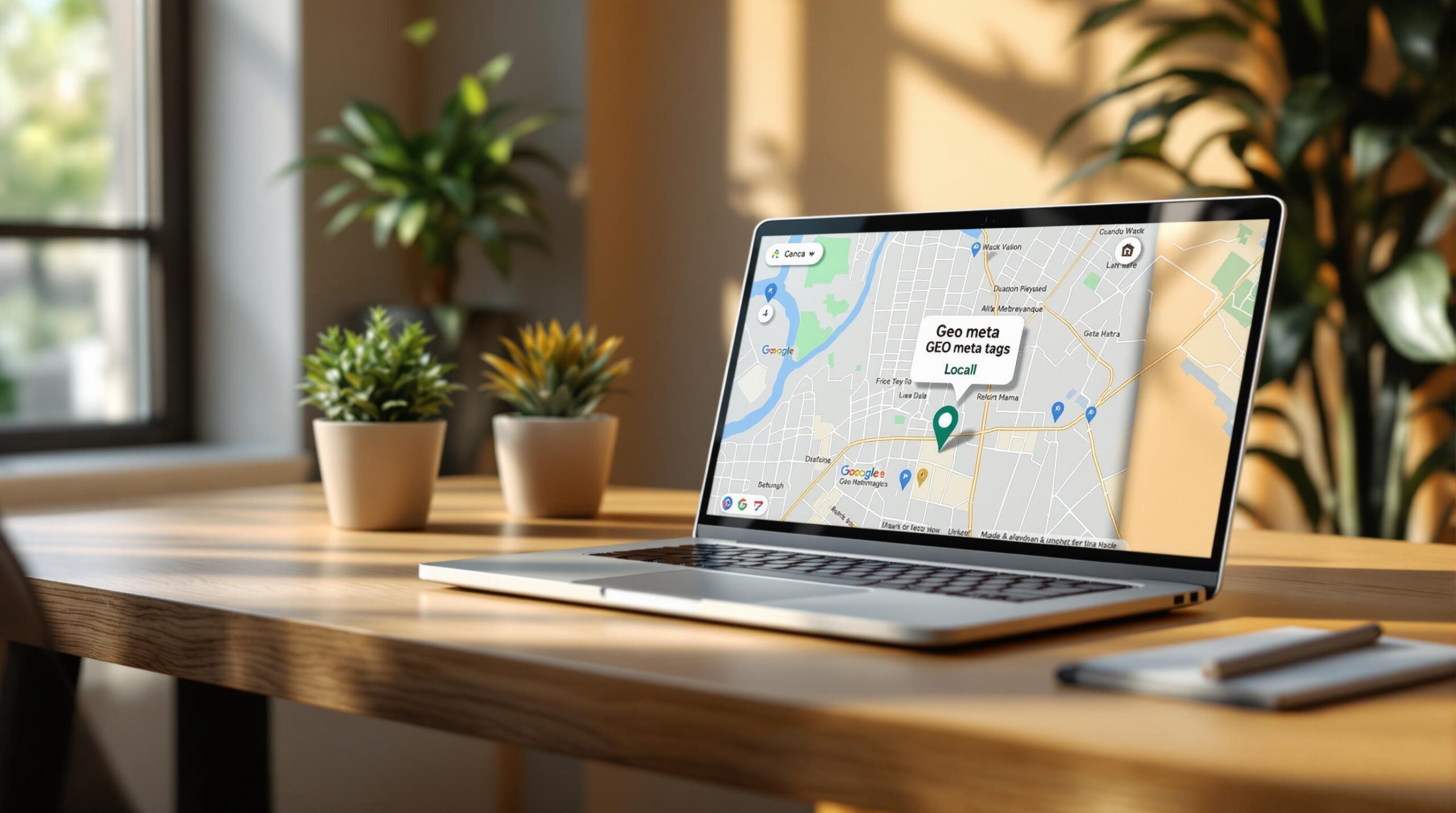Want to rank higher in local search results? Geo meta tags can help. These tags provide search engines with your website’s exact location, improving visibility for local audiences. Here’s what you need to know:
- What are Geo Meta Tags? They include details like latitude, longitude, region, and city to signal your location to search engines.
- Why Use Them? They boost your local SEO by connecting your site to nearby users.
- How to Add Them: Insert tags like
<meta name="geo.position" content="40.7128;-74.0060">into your website’s HTML<head>section. - Avoid Mistakes: Use correct formats, consistent data, and avoid fake locations.
Pair geo meta tags with schema markup and a consistent Google Business Profile for even better results. Start optimizing today for improved local search rankings.
Adding Geo Meta Tags to Websites
HTML Implementation Steps
To add geo meta tags to your website, make sure they are correctly placed in the <head> section of your HTML. Here’s how you can do it:
1. Access Your Website’s HTML
Open your website’s HTML file or access the header section through your CMS (like using WordPress plugins).
2. Insert the Tags
Place the following tags right after the opening <head> tag:
<meta name="geo.region" content="US-NY" /> <meta name="geo.placename" content="New York" /> <meta name="geo.position" content="40.7128;-74.0060" /> <meta name="ICBM" content="40.7128,-74.0060" /> These tags establish the basic structure for geo-targeted SEO.
3. Verify Proper Loading
Use developer tools to ensure the tags are loading correctly. You can also use tag generation tools to simplify the process.
Tag Generation Tools
There are tools available to help you create and validate geo meta tags more easily. Here are a few options:
| Tool Name | Primary Function | Key Features |
|---|---|---|
| Schema Markup Generator | Creates location-based schema | Validates coordinates, provides previews |
| GeoImager | Extracts coordinates from images | Processes EXIF data, supports batch tasks |
| Local Business Schema Creator | Builds local business markup | Offers templates tailored to industries |
These tools can save time and reduce errors during implementation.
Common Setup Mistakes
Avoid these typical errors when setting up geo meta tags:
Coordinate Format Issues
- Use semicolons (not commas) to separate coordinates in
geo.positiontags. - Double-check that latitude and longitude values are not swapped.
- Remove any unnecessary spaces in the coordinate values.
Regional Coding Problems
- Ensure country-state codes are formatted correctly.
- Include hyphens in region codes where needed.
- Avoid using outdated location identifiers.
Technical Oversights
- Don’t duplicate geo meta tags.
- Keep location data consistent across all tags.
- Ensure all required attributes are included.
Geo Meta Tag Guidelines
Ensuring Accurate Location Data
Your geo meta tags should precisely match your actual business location. This level of detail helps search engines correctly index your business and ensures it appears accurately in local search results.
Consistency Across Platforms
Keep your location details consistent across your website, business profiles, and local directories. This consistency not only boosts your local search visibility but also reinforces credibility with search engines.
Avoiding Spam Flags
Use geo meta tags only for real business locations. Adding fake or misleading location data can trigger spam penalties, as search engines prioritize genuine and accurate information.
These steps lay the groundwork for using geo meta tags effectively as part of your local SEO efforts.
Local SEO Optimization Tips For Geo Targeted Location Service Web Pages
sbb-itb-880d5b6
Local SEO Integration
Accurate geo meta tags are just the beginning. To truly strengthen your local SEO, combine them with structured data and ensure your Google Business Profile (GBP) details are consistent.
Schema Markup Connection
Pairing geo meta tags with schema markup can give your local SEO a powerful edge. Use the LocalBusiness schema to provide detailed information like your location, operating hours, and contact details.
Here’s what to focus on for schema markup:
- Ensure geo meta tag coordinates match your schema data.
- Include your complete address.
- Specify your service area boundaries.
- Clearly define your business category.
By syncing your structured data with the information in your Google Business Profile, you create a more cohesive and accurate online presence.
Google Business Profile Setup
Take your structured data efforts further by refining your Google Business Profile. Consistency is key:
- Make sure your Name, Address, and Phone (NAP) are identical across all platforms.
- Match your geographic service area in both geo meta tags and GBP.
- Use the same business categories for both your meta tags and GBP’s primary/secondary categories.
Local Content Strategy
Strengthen your local SEO with content that highlights your location. Incorporate local keywords, mention nearby landmarks, and reference events or community features.
Some ways to enhance your local content include:
- Creating localized landing pages with customer testimonials.
- Writing blog posts about local events or news.
- Using local keywords that align with your geo meta tags.
Performance Tracking
Once you’ve integrated geo meta tags with schema markup and local profiles, the next step is to evaluate how well they’re working.
Tracking the performance of geo meta tags is crucial for improving local SEO efforts.
Monitoring Tools
Here are some tools to help you monitor local search metrics effectively:
- Google Search Console: Analyze location-specific queries, click-through rates (CTR), and ranking changes for geo-targeted pages.
- Google Analytics: Examine user behavior metrics based on geographic locations.
- Local Rank Tracking Tools: Keep an eye on ranking shifts for location-specific keywords.
For a more hands-on approach, SearchX (https://searchxpro.com) provides a real-time dashboard designed to track geo meta tag performance. This tool can help businesses stay on top of their local SEO campaigns.
Key Metrics to Watch
Pay attention to these performance indicators to gauge success:
| Metric | Impact | Why It Matters |
|---|---|---|
| Local Visibility | Tracks ranking changes for geo-modified keywords | Shows how well you’re ranking in target areas |
| Geographic Traffic | Measures traffic from specific locations | Confirms that your local targeting is on point |
| Conversion Rate | Tracks conversions by location | Evaluates the business impact of your local efforts |
| Click-Through Rate | Monitors CTR from local search results | Indicates how appealing your local listings are |
Refining Your Strategy with Data
Use the insights from these metrics to make informed adjustments:
- Update content to better align with local search intent and boost rankings.
- Ensure your site meets technical standards for better visibility.
- Focus on location-based keywords that are driving meaningful traffic.
Conclusion
Key Advantages
Using geo meta tags can significantly improve local SEO performance. Here’s how:
| Advantage | Impact | Outcome |
|---|---|---|
| Geo-Specific Visibility | Better rankings for local searches | Improved placement in local packs |
| Targeted Traffic | Attracts visitors from specific areas | Increased local conversion rates |
| Precise Technical Signals | Clear location indicators for search engines | Enhanced search relevance |
| Data Uniformity | Consistent location details | Boosted authority in search results |
These advantages help lay the groundwork for fine-tuning your local SEO strategies.
How to Get Started
To effectively implement geo meta tags, follow these steps:
- Audit Your Site
- Confirm your website meets technical requirements.
- Ensure it’s mobile-friendly.
- Check for fast page loading speeds.
- Optimize Content
- Incorporate local keywords into your content.
- Update meta titles and descriptions to reflect your location.
- Align headers with location-based targeting.
- Strengthen Authority
- Secure high-quality backlinks.
- Standardize your NAP (Name, Address, Phone) data across platforms.
- Maintain consistent location details everywhere.
By following these steps, you can make the most of geo meta tagging to boost your local search visibility.
For expert assistance, SearchX offers services like geo meta tag setup, content optimization, and performance tracking. Learn more at SearchX.







